
Starting June 1st, 2023 Our warehouse fee will be $0.65/cubic foot per month
In effort to lower the warehouse storage fee during inflation, we have went narrow aisle racking.This construction took us four months but the project is finally completed. With narrow aisle racking, we are able to drop storage by 24%.We as partners will go through this inflation together.
04/03/2024
Do you know which port is the largest in the US? As “engines” of trade, they represent the relentless rhythm of international exchange, connecting distant shores and driving economic prosperity around the world, especially America.
The busiest seaports in the US are the "bases" of giants in the world shipping industry such as Maersk, ZIM, COSCO, Ever Green,... Join Worldcraft Logistics to explore more than 10 major seaports, find Understand its outstanding features and importance to transportation activities.
Get ready to dive into the latest update on the top 10 biggest ports in the US for 2024! From coast to coast, these maritime giants play a crucial role in shaping America's trade landscape. Join us as we explore the rankings and uncover the key players driving economic growth and connectivity across the nation's busiest waterways.
✔️ Total size: 7500 acres
✔️ Cargo terminals: 25
✔️ Vessels handled: 1867
✔️ Annual cargo tonnage: 222 million metric revenue tons, increase by 9.4 million TEU (Updated December 2024)
✔️ Annual cargo value: $294 billion
✔️ Leading trading partners: China and Hong Kong, Japan, South Korea
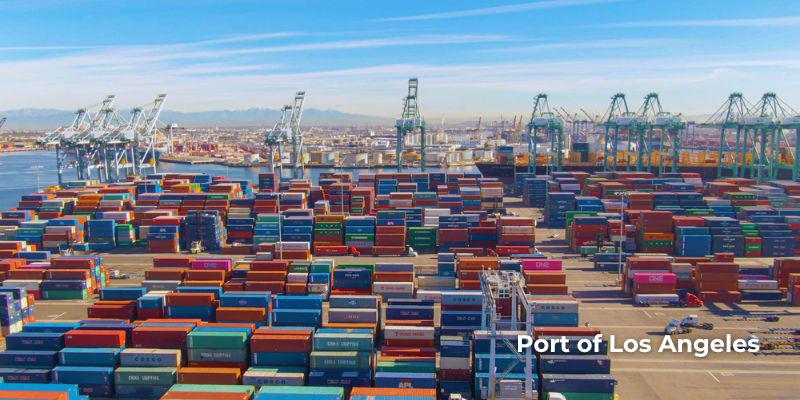
The Port of Los Angeles has been the busiest container port in North America for the past 22 years, transporting almost 10 million cargo containers each year. The port mostly handles transpacific commercial cargo. However, there have been numerous delays and bottlenecks at the Los Angeles port in recent months. The West Coast Port strikes, which only ended in July of 2023.
Shippers and freight forwarders began to transfer their cargo to the East Coast as a result of these delays. This was done to save money on expensive leasing fees and to stop their cargo from getting stuck at ports.
Therefore, even though the port handled more than 10 million TEUs in 2022, 2023 see a 26.85% decline in container volumes.
Renowned as one of the busiest ports worldwide, the Port of Los Angeles serves as the primary hub for the region, facilitating extensive trade between the United States and Asia. Comprising numerous terminals tailored to diverse cargo types, alongside a plethora of warehouses and storage facilities, it operates ceaselessly. With ships constantly arriving and departing, and containers being loaded and unloaded round the clock, its activity never wanes.
Furthermore, the Port of Los Angeles plays a pivotal role in driving both direct and indirect employment, with a staggering 1.6 million jobs dispersed across the United States, attesting to its widespread economic impact.
✔️ Total size: 3200 acres
✔️ Cargo berths: 80
✔️ Annual cargo tonnage: 78.2 million metric revenue tons, increase by 8.8 million TEU (Updated December 2024)
✔️ Annual container value: $180 billion
✔️ Direct and indirect employment: 370,000
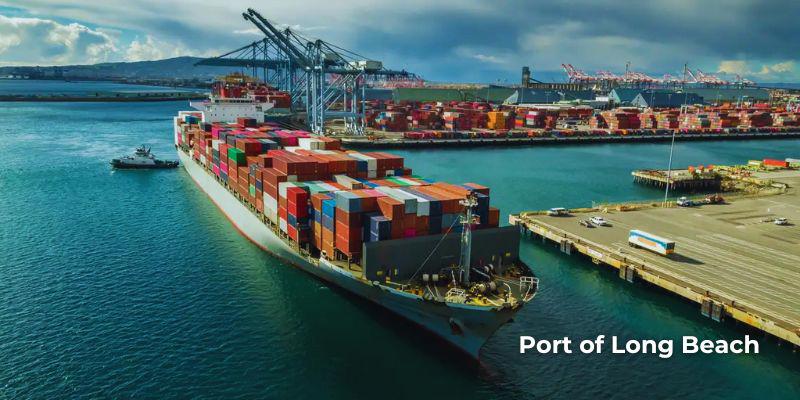
Ranked as the second-largest port on our roster, the Port of Long Beach sits just under 30 kilometers away from its Los Angeles counterpart. Since its founding in 1911, it has grown to become one of the busiest commercial entry points and a key hub for container shipping between Asia and North America. The port not only serves as a major entrance point for imported commodities but also manages a sizable amount of exports to locations all over the world.
Notably, the Port of Long Beach is renowned for its environment-friendly policies, including the implementation of the Green Port Policy and Clean Air Action Plan, further solidifying its reputation as a leader in sustainable maritime practices.
Some other articles to update your knowledge:
👉 TOP 10 largest 3PL companies with good service in the US
👉 Top 10 Best 4PL Businesses In The World Guaranteed Service
✔️ Container volume: 7.4 million TEUs, increase by 7.2 million TEU (Updated December 2024)
✔️ Total containers: 4.2 million
✔️ Annual cargo tonnage: 74 million metric revenue tons
✔️ Annual container value: $205 billion
✔️ Leading trading partners: China, India, Germany
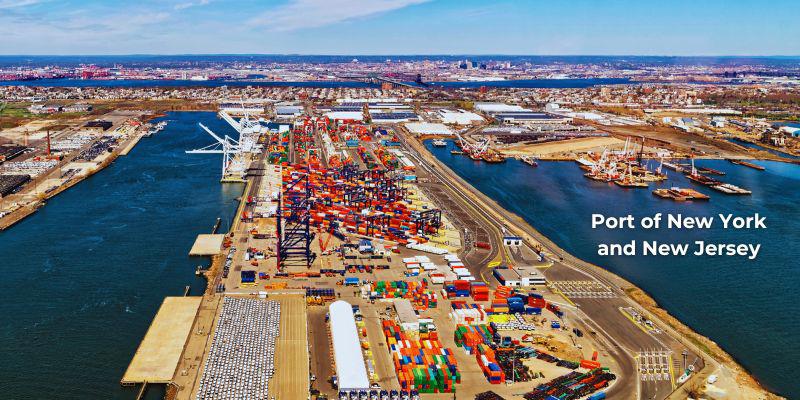
The main port on the US East Coast is the Port of New Jersey & New York, which is currently the third-largest port in the US.
In 2022, the volume of cargo entering the Port of New York and New Jersey rose by 5.7%. The roll-on, roll-off (RORO) cargo, break bulk, and project cargo are all handled at this port. All container types can be accommodated at its six ports and berths, together with the largest shipping vessels in the sector.
Receiving a staggering 72 percent of the region's initial port of calls. Annually, it deftly manages over 7.4 million containers, solidifying its status as a pivotal hub of maritime activity. Comprising three primary facilities: the Port Authority Marine Terminal, the Brooklyn Port Authority Maritime Facility, and the Newark Bay Extension. It spans the waterways of the New York-New Jersey Estuary, fostering seamless connectivity within the bustling metropolis.
Additionally, boasting two foreign-trade zones, it offers businesses unparalleled opportunities for streamlined operations and enhanced competitiveness in the international marketplace.
✔️ Container volume: Savannah alone handles 4.35 million TEUs, increase by 5.1 million TEUs (Updated December 2024)
✔️ Deepwater terminals: Garden City terminal (1200 acres), Ocean terminal (200 acres)
✔️ Primary goods: Automobiles, heavy machinery, agricultural products
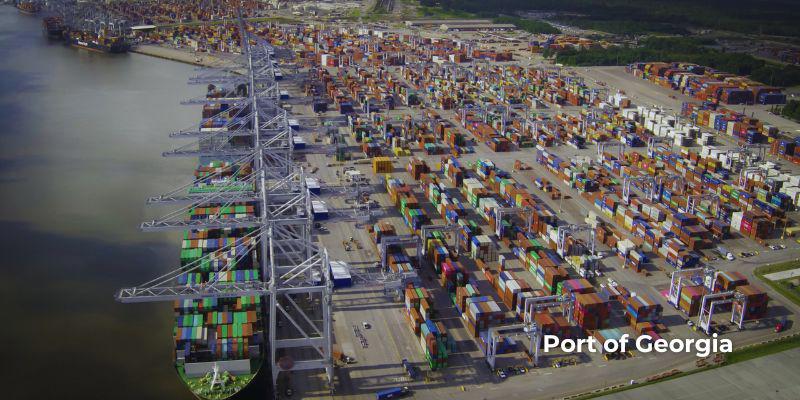
When all four Georgia ports are taken into account, Savannah and Brunswick come in at number four on our list of the biggest ports in North America. They provide a range of shipping services and facilities, such as cruise ship terminals, breakbulk terminals, and container terminals.
The Port of Savannah is home to the largest single-terminal container facility in the nation, whereas more than a dozen automakers use Brunswick as their primary import center. The Georgia Ports Authority oversees both ports.
The Port of Savannah stands out as home to the largest single-terminal container facility in the nation, showcasing its prowess in handling vast volumes of cargo. Meanwhile, Brunswick carves its niche as a premier hub for automobile imports, attracting business from over twelve leading auto manufacturers. Under the adept management of the Georgia Ports Authority, both ports operate seamlessly, contributing significantly to the state's economic vitality and global trade network.
Evidently, Savannah and Brunswick serve as indispensable pillars of Georgia's maritime infrastructure, driving commerce and fostering prosperity through their strategic positioning and unwavering dedication to excellence.
✔️ Container volume: 3.7 million TEUs
✔️ Total containers: 4.2 million
✔️ Primary exports: Oilseeds and grains, machinery, computers
✔️ Direct and indirect employment: 151,400
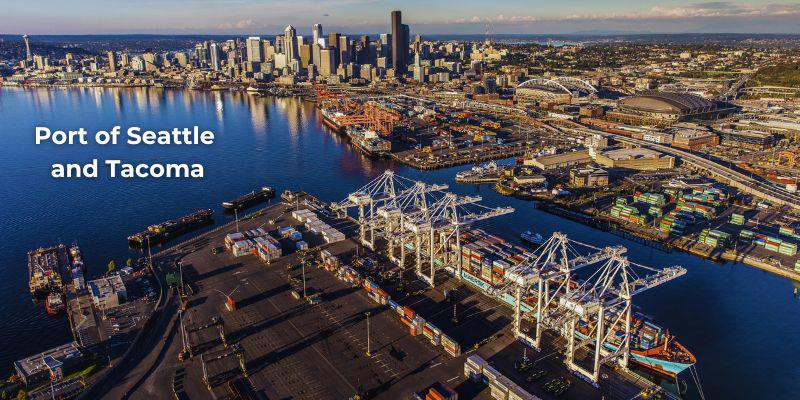
One of the busiest ports in the country is the Port of Seattle-Tacoma. It is situated on Puget Sound in Washington state. The port is a major entry point for trade with Asia and handles a lot of container traffic.
The two ports in Washington were combined in 2014 to form the Port of Seattle-Tacoma. It rose to the third-largest cargo handling company in America in 2015. The port, which contributes significantly to the local economy, generated $9.7 billion in revenue in 2017. The port invested $500 million on Terminal 5 modernization in 2019.
✔️ Vessel calls: 8200
✔️ Barges: 215,000
✔️ Annual cargo tonnage: 247 million metric revenue tons
✔️ Annual cargo volume: 1.6 million TEUs, increase by 3.8 million TEUs (Updated December )
✔️ Leading products: Petroleum and petroleum products
✔️ Economic impact on the state: $339 billion
✔️ Direct and indirect employment: 3.2 million
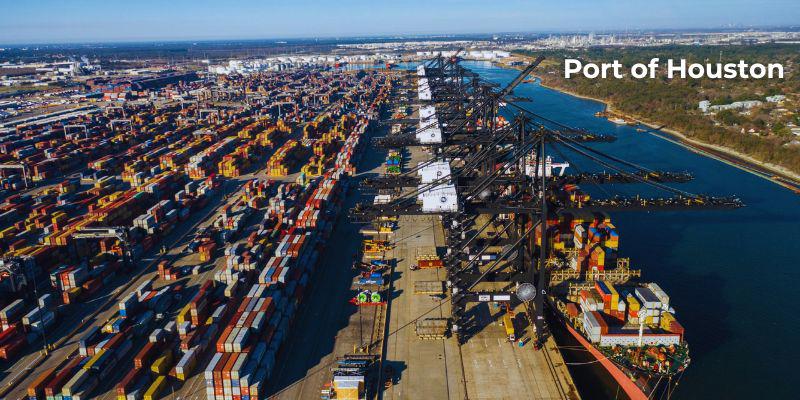
The Port of Houston is the busiest in America when it comes to international waterborne tonnage. There are more than 200 public and private terminals in the 50-mile-long port. The Houston Port, the largest port on the Gulf Coast, transports 52% of the region's project cargo. The NeoPanamax expansion is one of its current areas of emphasis.
Nearly 200 private businesses call the port, a significant hub for marine trade, their home. Each year, it transports more than 200 million tons of goods and generates more than $179 billion in economic activity. More than 1.2 million jobs in Houston are supported by the port, which is also a significant employer. Underscoring its pivotal role in driving economic prosperity.
✔️ Vessel arrivals: 1775
✔️ Annual container volume: 2.5 million TEUs
✔️ Leading trading partner: Asia
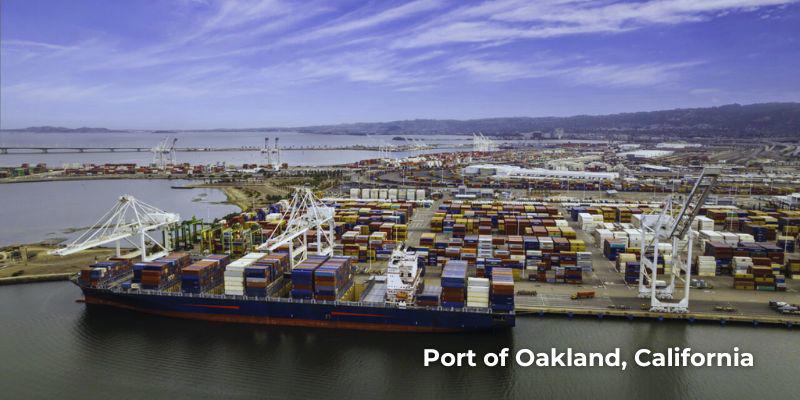
The Port of Oakland, which is situated on the San Francisco Bay, is the ninth busiest port in the US. The port is in charge of 1,300 acres of maritime-related infrastructure that cater to a local customer base of about 14.5 million people. It was the first significant port on the American Pacific Coast to construct container ship terminals.
After the ports of Los Angeles, Long Beach, Seattle, and Tacoma (NWSA), the Port of Oakland is one of the top four Pacific Coast ports for container shipping. Over 99% of the containerized commodities that pass through Northern California are transported through the port.
✔️ Annual cargo volume: 1.29 million TEUs
✔️ Foreign ports served: 100
✔️ Economic impact: $63.4 billion
✔️ Direct and indirect employment: 187,200
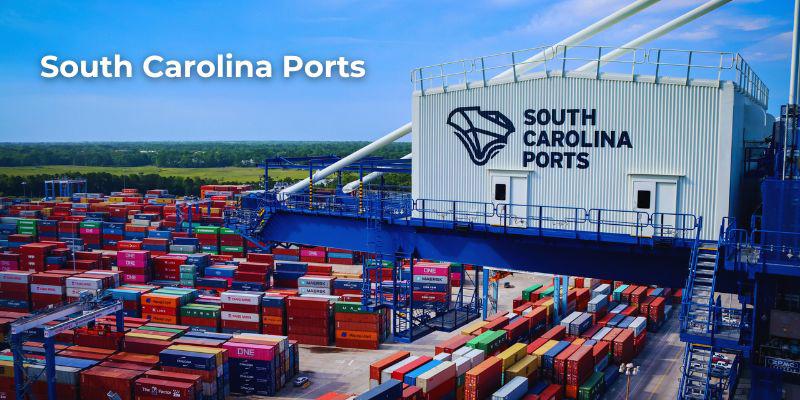
South Carolina Ports (S.C. Ports), which also operates the Port of Charleston and four additional significant ocean terminals, is the tenth busiest port in the US. The Ports of Georgetown, Charleston, Inland Port Greer, and Dillon are owned and run by the S.C. Ports. 10% of all jobs in the state are directly or indirectly supported by the ports of South Carolina.
With a pronounced emphasis on container handling, the ports collectively manage over two million TEUs (twenty-foot equivalent units) annually. Furthermore, they serve as pivotal hubs for the import and export of automobiles, as well as bulk commodities like coal and forest products.
✔️ Major terminals: 25
✔️ Vessels handled: 2677
✔️ Annual cargo tonnage: 147 million metric revenue tons
✔️ Container volume: 3.4 million TEUs
✔️ Annual cargo value: $240 billion CAD
✔️ Direct and indirect employment: 115,300
✔️ Impact on GDP: $11.9 billion
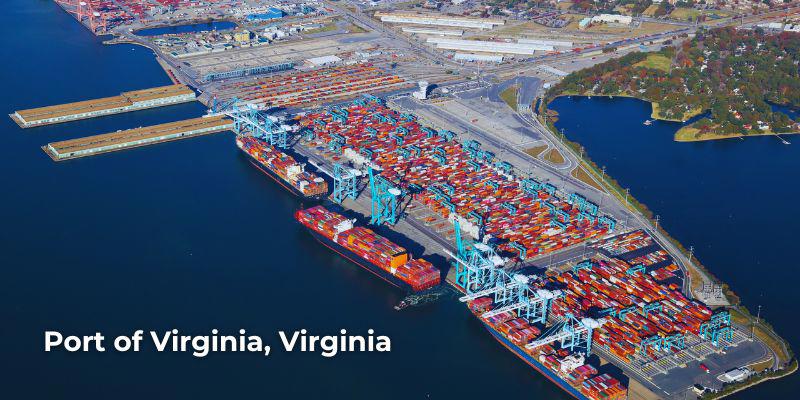
With millions of tons of goods handled each year, the Port of Virginia is one of the busiest and most significant seaports on the East Coast. The port is situated in Virginia's Hampton Roads area, where the James River and Chesapeake Bay meet.
One of the busiest ports on the East Coast, the Port of Virginia, has been expanding at a 2.6% yearly rate over the past five years. It can only get busier at the port as global corporations like Amazon and Navien establish facilities there.
The principal terminals in this area are Norfolk, Portsmouth, Newport, Virginia International, and Virginia Inland. The Savannah and Virginia ports' Georgia-Virginia partnership has been approved by regulators, and the port is anticipated to gain significantly from the combined economies of scale.
✔️ Container volume: 1.2 million TEUs
✔️ Notable: Deep Dredge Project for accommodating larger ships
✔️ Revenue: More than $41 billion annually
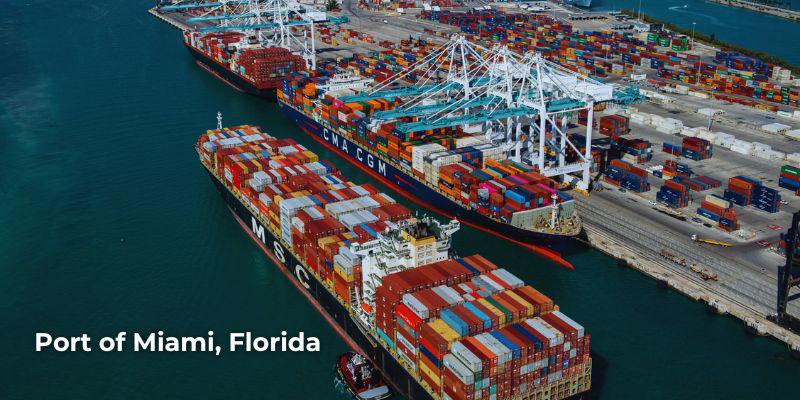
The Port of Miami, which made it to our top 10 list, handled 1,114,900 TEUs in 2022. Did you know that it is the only harbor in the South East that can accommodate Neo-Panamax ships? This is due to the fact that it boasts the deepest shipping channel of any seaport in the Southeast.
Grapefruit, citrus fruit juices, poultry, dairy goods, bitters, brandy, and cognac are among the exports from this country. Fruits, vegetables, frozen fish, shrimp, prawns, wine, and vodka are among the imported goods.
The Port of Miami is renowned for its versatility, efficiently managing a wide array of cargo while proudly claiming the distinction of being the world's largest cruise port. Notably, recent transformative infrastructure initiatives, like the Deep Dredge Project, have bolstered its capabilities and connectivity, ushering in a new era of maritime excellence.
Although not as famous as major seaports, some other import-export seaports in the US still play an important role in the international freight forwarding system. So which ports are mentioned? Below is a list for your convenience
Num. | Name of port | Basic infomation |
1 | Port of Baltimore, Maryland | The Helen Delich Bentley Port in Baltimore is situated on the upper northwest shore of Chesapeake Bay, between the tidal basins of three branches of the Patapsco River. It is the largest port in the country in terms of both passenger and specialized cargo (roll-on/roll-off ships) facilities. There are currently significant bulk handling facilities and ro-ro (roll-on roll-off) facilities, particularly for steel. Each year, about 700,000 cars travel through the port. Additionally, imports of Mercedes-Benz are managed here as well. The Port of Baltimore was ranked ninth in terms of the monetary worth of cargo carried and ranked eleventh in terms of tonnage handled by foreign ships out of 36 ports examined in the USA. |
2 | Port of Wilmington | The port, which is situated in Wilmington, Delaware at the meeting point of the Christina River and the Delaware River, has been recognized as one of the top ports for the importation of fresh fruit, bananas, and juice concentrate. It also has the largest dock-side cold storage facility in North America. The port is also a Foreign Trade Zone and a C-TPAT approved location. The port is considered to be one of the top US ports due to its capacity to handle complex goods. |
3 | Port of Cleveland, Ohio | At the Cuyahoga River's mouth on Lake Erie in Cleveland, Ohio, the Port of Cleveland is a bulk cargo and container shipping port. The Cleveland-Europe Express provides twice-weekly service between Cleveland and Antwerp, making it the third-largest port in the Great Lakes and the fourth-largest Great Lakes port by yearly tonnage. It is also the only container port in the Great Lakes.. The annual flow of nearly 13 million tons of cargo through Cleveland Harbor supports over 20,000 employment and $3.5 billion in economic activity. In order to compete with foreign alternatives, companies can use special customs procedures in the Port of Cleveland, the grantor of the Foreign Trade Zone, to encourage domestic business and value addition by delaying or reducing duty payments on imported goods and creating other savings. |
4 | Port of Norfolk | Virginia is where the Port of Norfolk is situated. 3,700,000 TEUs can fit inside. The South Terminal, the North Terminal, and the Central Rail Yard are the three divisions of this port. China is the port's main trading partner. Soybeans, grain goods, cereal, flour, bulk grains, and tobacco products are among the exports from this country. Coffee, vodka, bitters, brandy, cognac, vegetables, and nuts are among the imports. |
5 | Port of Charleston | In the fiscal year 2022, the Port of Charleston handled 2,850,001 TEUs. Keep in mind that this port has its own free-trade zone, setting it apart from other ports if you wish to avoid paying duties on your goods. There are no tariffs on any goods coming into or leaving the port of Charleston, allowing for unfettered import and export. Here, furniture, chemicals, textiles, and machine parts are the leading exports. There are no tariffs on any goods coming into or leaving the port of Charleston, allowing for unfettered import and export. Here, furniture, chemicals, textiles, and machine parts are the leading exports. |
6 | The Port of Beaumont | The Port of Beaumont, a political division of the State of Texas, runs as a hybrid deep draft port (both operational and landlord). According to the American Association of Port Authorities, it is the fourth busiest port in the United States and the forty-seventh busiest port in the world in terms of tonnage. It also serves as the headquarters for the 842d Transportation Battalion of the United States Army, which specializes in port logistics and is the busiest port in the world for processing U.S. military equipment. |
With the provided information, it is hoped that you now possess a more intriguing understanding of the largest ports in the United States (USA), particularly when considering sea freight shipments to the US.
SEO
Digital Marketing/SEO Specialist
Simon Mang is an SEO and Digital Marketing expert at Wordcraft Logistics. With many years of experience in the field of digital marketing, he has shaped and built strategies to effectively promote Wordcraft Logistics' online presence. With a deep understanding of the logistics industry, I have shared more than 500 specialized articles on many different topics.

Hot News
08/05/2024

Hot News
02/23/2023

Hot News
02/23/2023

Hot News
02/06/2023
Hot News
02/07/2023